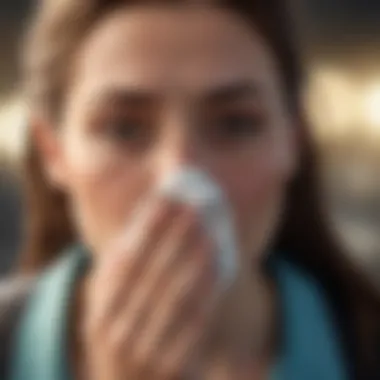Effective Strategies to Relieve Sneezing: Insights and Tips


Intro
Sneezing is a reflex that everyone experiences, yet its causes and consequences can span a variety of domains. It often seems trivial but can significantly impact quality of life. Understanding the mechanisms behind sneezing can aid both individuals and health professionals in developing effective methods for relief. This article will explore strategies that not only address immediate concerns but also focus on long-term management strategies.
Well-Being Overview
Prolusion to the topic
Sneezing can be both a nuisance and a signal from the body, alerting us to allergens or irritants. It may arise from various triggers including dust, smoke, or seasonal allergies. Identifying these triggers is essential for targeted intervention.
Importance of focusing on this aspect of well-being
The discomfort and disruption caused by frequent sneezing affect personal and professional engagements. Acknowledging and addressing this issue is key for overall well-being. Reducing the impact of sneezing can lead to improved social interactions and enhance life quality.
Triggers of Sneezing
Understanding the triggers for sneezing is paramount. Common factors include:
- Environmental allergens like pollen or pet dander
- Airborne irritants such as smoke and strong odors
- Medical conditions including colds or sinus infections
Proper identification can lead to more focused management strategies.
Immediate Relief Strategies
When faced with acute sneezing, several approaches can provide quick relief:
- Nasal irrigation, using saline solutions to flush out irritants.
- Antihistamines, which can effectively reduce allergic reactions.
- Controlled breathing techniques, calms the body and can interrupt the sneezing cycle.
Effective relief often springs from simple and direct actions.
Long-Term Management Strategies
For chronic sneezing, an ongoing strategy is necessary:
- Avoidance of known allergens, when possible.
- Allergy testing, meeting with specialists to create a personalized plan.
- Making environmental adjustments, such as using air purifiers or dehumidifiers.
Managing sneezing becomes easier with knowledge and proactive practices. The insights gained here are intended to provide thorough understanding and actionable solutions, ensuring that sneezing’s disruptive nature diminishes over time.
Through the combination of immediate and long-term strategies, individuals can gain control over their sneezing experiences.
Understanding Sneezing
Understanding the mechanisms and implications of sneezing is crucial for developing effective methods to relieve this sometimes disruptive symptom. Given the complexity of what prompts sneezing, individuals can better manage their condition with insight into its nature. The physiological process and common triggers help identify appropriate treatments and interventions. This section serves as a foundation, facilitating a more thorough comprehension needed for both immediate and long-term relief strategies.


What is Sneezing?
Sneezing is a reflex action characterized by an involuntary expulsion of air from the lungs through the nose and mouth. Often, it is a natural response of the body, acting as a complex defense mechanism against irritants in the nasal passages. When triggered, signals are sent to the brain, leading to a quick inhalation followed by a forced expulsion. It may occur when certain substances stimulate the mucous membranes, showcasing its role in cleaning the respiratory tract.
The Physiology of Sneezing
The sneeze reflex includes a series of coordinated bodily functions. The process typically starts when an irritant, such as dust or pollen, is detected. The sensory nerves in the nasal cavity transmit signals to the medulla oblongata in the brainstem. Here, the centers responsible for breathing and motor control sync, creating a rapid inhalation. Following this, the sudden closure of the vocal cords builds pressure. Finally, the vocal cords open, leading to an explosive release of air.
This response is essential. By clearing out the irritants, sneezing safeguards the body from potential harm. Understanding this physiological context helps individuals appreciate the instinctive occurrence of sneezing.
Common Triggers of Sneezing
Certain factors frequently activate the sneeze reflex. Recognizing these triggers is significant for effective intervention. Major triggers include:
- Allergens: Common materials, such as pollen, pet dander, and mold, frequently cause sneezing. These allergens provoke an immune reaction, clearing the nasal passageways.
- Irritants: Smoke, strong odors, and chemical vapors can irritate nasal linings, leading to sneezing.
- Environmental Changes: Sudden shifts in air temperature or humidity can induce sneezing, particularly in sensitive individuals.
- Infections: Upper respiratory infections can lead to sneezing, as the body tries to expel viral agents.
Understanding these factors creates a path for effective management. It fills the knowledge gap and informs lifestyle adjustments and relief strategies tailored to limit exposure and enhance overall quality of life.
Immediate Relief Strategies
Immediate relief strategies play a crucial role in the context of sneezing management. These quick methods provide individuals the means to alleviate symptoms as they arise. Sneezing disrupts daily activities and may indicate underlying health issues. Having effective tactics ready can improve comfort and focus. Furthermore, understanding immediate terminology offers angles on effective self-care.
Avoiding Known Triggers
The first line of defense against unnecessary sneezing is avoiding known triggers. Identifying and steering clear of these irritants can significantly reduce the frequency of episodes. Common triggers include pollen, dust, pet dander, and various airborne particles. Keeping a diary to track sneezing occurrences can be helpful in pinpointing offending substances. Once the most potent triggers are determined, physical measures such as:
- Keeping windows closed during high pollen days
- Using air purifiers
- Frequent cleaning to reduce dust buildup
can be implemented to maintain a sneeze-free environment.
Nasal Irrigation Techniques
Nasal irrigation is a practice that helps clear irritants from nasal passages. Utilizing saline solutions, individuals can flush out particles that often cause sneezing. Neti pots or squeeze bottles designed specifically for this purpose can be effective tools. Using sterile water and ensuring proper hygiene are important steps for successful nasal irrigation. Evidence evident suggests a reduction in sinus irritation and improved overall nasal health can result.
Over-the-Counter Antihistamines
Over-the-counter antihistamines like cetirizine and loratadine are common pharmacological solutions. These medications block receptors in the body that trigger allergic reactions, thus preventing sneezing. They come in various forms, including tablets and liquids, allowing flexibility based on personal preferences. Important to note is that some antihistamines can cause drowsiness; checking labels is paramount. Understanding the right time and choice for antihistamines can enhance their efficacy for immediate relieve.
The Role of Humidifiers
Elevating indoor humidity levels can also mitigate triggers for sneezing. The dryness of air during certain seasons contributes to nasal irritation. Using a humidifier adds moisture back into the air and decreases irritation in respiratory tracts. Generally, a humidity range of 30% to 50% is optimal. Maintenance of the humidifier is essential to prevent mold growth, a potential source of allergens.
"When considering the methods for immediate relief, it is essential to explore options without self-neglect. Maintaining a proactive stance is beneficial."
Employing these immediate strategies allows for rapid response to sneezing, contributing to overall discomfort reduction and enhancement of daily living.


Environmental Adjustments
Environmental adjustments play a critical role in managing and relieving sneezing. These adjustments focus on creating a suitable living environment that minimizes exposure to potential triggers. Often, sneezing is exacerbated by allergens and irritants found indoors. By implementing effective strategies, it is possible to develop a more comfortable and healthier indoor space.
Maintaining Indoor Air Quality
Indoor air quality is vital for respiratory health. Poor air quality can increase exposure to allergens like dust mites, pet dander, and mold, all of which are contributors to sneezing. Improving indoor air quality involves taking specific steps:
- Regular Ventilation: Open windows when possible to allow fresh air to circulate. If outdoor air quality is good, fresh air can dilute allergens and irritants indoors.
- Air Purifiers: High-efficiency particulate air (HEPA) purifiers can significantly reduce airborne allergens. Make sure a suitable air purifier is used, particularly in bedrooms and living areas.
- Humidity Control: Maintaining relative humidity between 30-50% helps reduce dust mites and mold growth. Dehumidifiers can be beneficial in damp areas such as basements.
Quality of inhaled air directly affects the frequency and intensity of sneezing. Poor indoor air can be subtly harmful yet overtly present dangers.
Managing Allergens at Home
Proper management of allergens at home is essential in minimizing sneezing episodes. Individual efforts in maintaining cleanliness and reducing allergen accumulation can make a significant difference. Here are keys areas to consider:
- Regular Cleaning Routines: Dust and vacuum weekly using a HEPA filter vacuum. This helps to trap allergens that usual cleaning may miss.
- Wash Bedding Frequently: Wash pillowcases, sheets, and blankets in hot water at least once a week to eliminate dust mites. Likewise, mattress and pillow covers should be encasements designed to keep allergens out.
- Declutter: Reducing clutter minimizes the number of places where dust and allergens can settle. Keep surfaces clear and organized.
- Pet Management: If pets are present, consider keeping them out of bedrooms or off furniture to reduce dander exposure.
Seasonal Considerations
Seasons can dramatically alter the types and levels of allergens present, thereby influencing sneezing behavior. Understanding these variations is beneficial:
- Spring: Pollen from trees and flowers is most prevalent in spring. Keeping windows closed and using air conditioning may help mitigate exposure.
- Summer: Grass pollen spikes during the summer, so engaging in outdoor activities in the evening may reduce exposure.
- Fall: Ragweed pollen can be a problem in fall. Understanding when pollen counts peak can assist in planning outdoor activities.
- Winter: Use of heaters often lowers indoor humidity, which can increase dust levels, leading to more irritants circulating. Regular humidification practices can help counteract dryness.
By embracing environmental adjustments, one can effectively create a safer haven against sneezing triggers. These changes often lead to a considerable improvement in overall comfort and wellness.
Long-Term Management Techniques
Long-term management techniques are crucial for individuals who experience frequent sneezing. Understanding the underlying causes can pave the way for effective management strategies. These techniques are not just about momentary relief; they emphasize the need for comprehensive approaches that use medical data and behavioral changes. The benefits can significantly improve the quality of life for many. While immediate relief components like antihistamines and humidifiers serve their purpose, a sustained focus on long-term management leads to improved health outcomes.
Identifying Allergies Through Testing
Identifying specific allergies is a key point in long-term management. There are different methods to test for allergies, including skin prick tests and blood tests. Skin prick tests are quick and easier to administer, giving immediate results regarding reactivity to common allergens. Blood tests like the ImmunoCAP can quantify specific IgE levels, showing how strongly a person reacts to particular allergens. Knowing these details is essential. This helps to target avoidance strategies more accurately and set the foundation for more effective management plans. Healthcare providers often recommend these tests to build an accurate allergy profile.
Implementing an Allergy Management Plan
Once allergies are identified, creating an allergy management plan is an essential step. This plan focuses on three primary areas: avoidance of known triggers, control of symptoms when exposure is inevitable, and regular follow-up evaluations. In some cases, avoidance means making changes in everyday environments, such as using air purifiers, keeping windows closed during high pollen seasons, or even considering medicated help for pets if needed.
-Allergy management is not often a 'one-size-fits-all' process. Implement personalized plans based on individual trigger responses. Keep records of what works best through adjustment.
- Assess allergen exposure regularly.
- Consider immunotherapy (allergy shots) if recommended by a healthcare provider.
- Educate family and friends so they can support your strategies.
Engaging everyone in the plan fosters a more supportive living environment, minimizing common allergens effectively.


Lifestyle Modifications for Sneezing Relief
Lifestyle changes can significantly alleviate the frequency of sneezing. These alterations don’t come as quick fixes but rather as gradual improvements that sustain better health.
Here are some key lifestyle modifications:
- Regular exercise: Physical activity strengthens the immune system, which can lead to fewer respiratory issues.
- Balanced nutrition: Foods high in omega-3 fatty acids, antioxidants, and probiotics can contribute to better lung health.
- Mindfulness and relaxation techniques: Stress often affects immune responses; adopting practices like yoga or meditation can improve resilience against allergic reactions.
- Hygiene practices: Frequent washing of hands and regular cleaning of living spaces can minimize allergen accumulation.
Making these lifestyle adjustments not only helps with sneezing management but can also contribute to overall well-being.
A careful orchestration of allergy management plans combined with lifestyle tips will ultimately enhance your ability to thrive in daily life without the disruptions caused by sneezing.
When to Seek Professional Help
Understanding when to seek professional assistance is crucial in effectively managing sneezing, especially when it is persistent or linked to other serious symptoms. Sneezing can be a mild discomfort or a signal of something more harmful. Recognizing the right time to consult an expert can lead to effective treatment and improve one’s overall quality of life.
04083Real issues arise when sneezing is unmanageable or occurs alongside other severe symptoms. They can indicate an underlying health problem that needs attention. Failing to get appropriate medical help can result in exacerbated symptoms or complications.
Recognizing Severe Symptoms
Certain symptoms can signal a more serious health issue. Paying close attention to such indicators is vital. If sneezing is accompanied by the following symptoms, it may warrant immediate professional consultation:
- Persistent fever
- Shortness of breath
- Chest pain
- Swelling of the throat
- Unusual rash or hives
- Blood in nasal discharge or saliva
Each of these symptoms can point towards a range of conditions, from allergies to infections. If any of these arise, understanding when to contact a healthcare provider can be life-saving.
"Some sneezes are simply allergic reactions, while others can indicate something more serious. Pay attention to your body’s signals."
Consultation with a Healthcare Provider
Consulting with a healthcare provider can clarify the reasons behind persistent sneezing. During the appointment, be prepared to discuss:
- History of Symptoms: Document when sneezing occurs and what seems to trigger it.
- Allergy History: Mention any known allergies or treatments that have been previously explored.
- Family Medical History: Some conditions are hereditary. Family history can provide crucial context.
A thorough examination often involves allergy testing, which can help identify specific triggers. Implementing an effective treatment plan starts with understanding the root causes of sneezing.
Healthcare providers can also recommend lifestyle modifications, medication options, or even refer to specialists if needed. Based on individual symptoms, healthcare experts may suggest strategies tailored to effectively alleviate the underlying causes of sneezing, enhancing long-term wellness.
End
Understanding and addressing sneezing is essential, given its potential to significantly impact quality of life. Sneezing, while often seen as a minor annoyance, can be a symptom of underlying health issues or environmental triggers. The need for effective relief strategies can therefore not be understated. This article emphasizes both immediate and long-term methods to effectively manage sneezing so that it remains a manageable concern.
Recap of Effective Sneezing Relief Methods
To synthesize the presented content in earlier sections, several effective methods have been explored. These include:
- Recognizing and Avoiding Triggers: Knowing what causes your sneezing can lead to better control over symptoms.
- Nasal Irrigation Techniques: These help achieve clear nasal passages, especially valuable during allergy season.
- Antihistamines: Over-the-counter options can ease the symptoms effectively.
- Environmental Modifications: Maintaining a clean space and monitoring air quality can mitigate allergen exposure.
- Professional Consultation: When necessary, seek expert guidance to further investigate and treat persistent sneezing.
Effective management can improve not just health but overall well-being. A proactive approach encourages individuals to recognize the symptoms, find suitable immediate relief methods, and adopt practices that contribute to their long-term health.
In summary, by addressing the whys and hhow's of sneezing, readers can navigate through symptoms more effectively, allowing for a healthier and more functional lifestyle.



